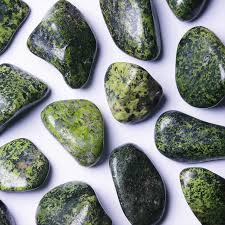
Nephrite: The Earth’s Gentle Protector in Raw Crystal Form
Among the various stones associated with protection and endurance, Nephrite often stands quietly behind its more famous counterpart, Jadeite. But those who know Nephrite understand its whispered power, ancient legacy, and deep resonance with the body and earth. In its raw, unpolished form, Nephrite carries the soul of the mountains, connecting wearers to ancestral wisdom, physical vitality, and grounded serenity.
Geological Profile: Composition, Structure, and Origin
Nephrite is one of two distinct minerals known collectively as jade—the other being jadeite. Composed primarily of calcium magnesium iron silicate, Nephrite belongs to the amphibole group of minerals, forming through metamorphic processes in serpentine-rich rocks. Its structure is fibrous and compact, contributing to its renowned toughness—a quality historically appreciated for both ornamental and utilitarian use.
Key Properties:
-
Hardness: 6–6.5 on the Mohs scale
-
Crystal System: Monoclinic
-
Typical Colours: Creamy white, grey-green, rich mossy green to deep olive or nearly black
-
Main Sources: British Columbia (Canada), New Zealand, Siberia (Russia), China, the USA
Raw Nephrite often reveals velvety sheens and subtle colour marbling, with forms ranging from smooth river stones to jagged chunks that hint at their geological journey.

Energetic and Healing Uses
Nephrite is known for its nurturing frequency—it gently strengthens, restores and protects. Unlike more “fiery” protection stones, Nephrite works subtly, like the steady presence of an elder or guardian.
Emotional and Spiritual Meanings:
-
Protection: Forms an energetic shield against negativity, not by repelling but by absorbing and transmuting.
-
Vitality & Healing: Encourages physical wellness, stamina, and energetic resilience—often linked to the heart chakra and kidneys.
-
Emotional Balance: Offers comfort in times of grief or transition, softening the weight of change.
-
Connection to Ancestors: Revered in Māori and Chinese traditions, Nephrite is often seen as a conduit to ancestral wisdom and intergenerational strength.
Used in meditation, raw Nephrite can anchor the breath, deepen introspection, and gently attune one to the rhythm of the natural world.
Collector’s Perspective: Natural Beauty and Intrinsic Value
Collectors value Nephrite not for brilliance or transparency, but for its textural subtlety and tactile charm. Especially in its raw form, Nephrite tells a more earth-rooted story—unvarnished, robust, and timeless.
High-grade Nephrite specimens are sought after for:
-
Unique colourations (such as rare white or golden hues)
-
Historic provenance (e.g., Russian Baikal or Chinese Hetian Nephrite)
-
Unusual fibrous patterns or surface textures
While not traditionally prized in the gem market for brilliance, Nephrite’s rarity in certain regions and cultural reverence elevate its status among connoisseurs of mineral specimen jewellery.

Nephrite in Jewellery: Raw Grace and Mineral Strength
Though commonly polished into beads or cabochons, raw Nephrite is increasingly cherished in its unrefined state—especially among wearers seeking a deeper connection to the earth and the stone’s innate spirit. In mineral specimen jewellery, Nephrite becomes more than an ornament; it becomes an anchor.
Why Raw Nephrite?
-
Energetic integrity: Untreated Nephrite retains its full vibrational field, supporting more profound energetic work.
-
Aesthetic rawness: Its tactile surface and earthy hues provide a perfect counterbalance to modern minimalism or nature-inspired styling.
-
Symbolic durability: Nephrite's natural toughness echoes the wearer's inner resilience.
In forms such as crystal specimen rings, mineral specimen necklaces, or handmade gemstone rings, Nephrite lends a grounding energy with a minimalist edge. At Oryssia, we honour its unpolished beauty and forge pieces that celebrate its tactile strength and ancestral roots.
Cultural Legacy and Spiritual Traditions
Nephrite has been revered for millennia, particularly in East Asian, Pacific, and Siberian cultures.
-
China: For over 6,000 years, Nephrite (often called “true jade”) has symbolised purity, nobility, and moral integrity. Confucius himself wrote of jade’s virtues.
-
New Zealand (Aotearoa): The Māori people treasure Nephrite (known as pounamu) as a taonga—a sacred treasure. Often carved into tools, weapons, and heirlooms, it represents strength, protection, and lineage.
-
Siberia: Indigenous peoples regarded Nephrite as a healing stone, using it in shamanic traditions to ward off illness and spiritual unrest.
These traditions remind us that Nephrite is more than a mineral—it is a cultural bridge and a spiritual companion.
Comparison to Jadeite: Kindred Yet Distinct
While often lumped together under “jade,” Nephrite and Jadeite differ geologically, energetically, and aesthetically.
| Property | Nephrite | Jadeite |
|---|---|---|
| Composition | Calcium magnesium silicate | Sodium aluminium silicate |
| Hardness | 6–6.5 | 6.5–7 |
| Texture | Fibrous and silky | Granular and sugary |
| Energy | Nurturing, protective, grounded | Elevating, invigorating, active |
| Colour range | Greens, browns, whites | Bright greens, lavender, multicolour |
For those seeking a more gentle, earthy, and protective stone, Nephrite is often the more aligned choice—especially in its raw crystal jewellery form.
Closing Reflections: Nephrite for the Now
In our fast-moving world, Nephrite offers a quiet revolution: protection without armour, strength without aggression, beauty without exaggeration. Its raw form speaks directly to the heart and hands of those seeking deeper grounding, resilience, and remembrance.
Whether you’re adorning yourself with a crystal specimen ring, keeping a raw chunk in your space, or simply connecting with its energy during quiet moments, Nephrite invites you to stand rooted and move steadily.
For seekers drawn to ancient strength and gentle guidance, raw Nephrite is a timeless companion.